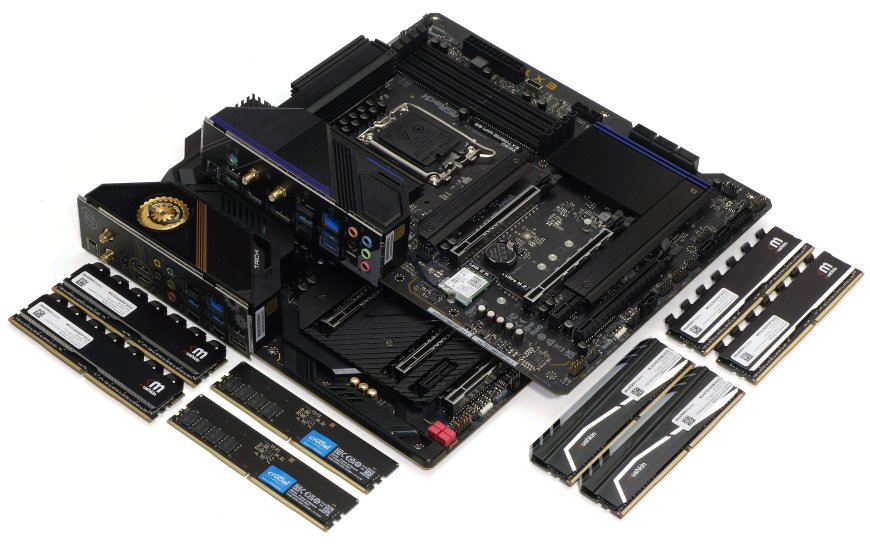DDR5 vs. DDR4: A Fresh Look at Gaming Performance
In this comprehensive analysis, we dive into the DDR4 vs. DDR5 memory debate, utilizing Intel's latest Core i9-14900K processor. It's been nearly two years since we last compared these memory standards, and we aim to provide an updated perspective. This time, we're armed with DDR5-7200 and DDR4-4000 memory, allowing us to assess their performance accurately.

Memory Evolution: DDR4 to DDR5
The memory landscape has evolved since our last comparison, with DDR5 memory emerging as the new standard. We previously tested the i9-12900K with DDR5-6000 and DDR4-3600 memory, but now we've upgraded to DDR5-7200 and DDR4-4000. This shift in memory speed sets the stage for a fresh evaluation of gaming performance.
Also check ASRock Radeon RX 7900 XTX Taichi
Pricing Surprise: DDR4 vs. DDR5
In a surprising turn of events, DDR4 memory now carries a higher price tag than DDR5. The G.Skill Ripjaws V Series 32GB DDR4-4000 CL16 kit is priced at $170, whereas the G.Skill Trident Z5 RGB Series 32GB DDR5-7200 CL34 kit is available for a more affordable $130. This shift in pricing dynamics raises questions about the cost-effectiveness of DDR4 compared to its newer counterpart.
Gaming Performance Showdown
Our review focuses on one crucial question: how does DDR4 stack up against the newer DDR5 standard in modern gaming? While we acknowledge that the buying advice for new system builders is relatively straightforward – opt for DDR5 – we delve into the nuances of their performance differences to satisfy our curiosity.
DDR5: The Modern Choice
For new system builders, DDR5 is the logical choice. It boasts higher performance and comes at a reasonable price point. A 32GB DDR5-5600 kit can be obtained for just $70, while DDR4-3600 kits start at around $55. Moreover, both DDR4 and DDR5 motherboards are available at similar price points, with DDR5 models now more readily accessible.
Testing Methodology
To provide a fair and accurate assessment of DDR4 vs. DDR5 gaming performance, we employed a comprehensive testing methodology. Our setup includes the Intel Core i9-14900K processor, ensuring that we're using the latest hardware to match the memory standards. We'll analyze gaming performance across a range of modern titles to gauge any noticeable differences between DDR4 and DDR5.
Benchmarking: DDR4 vs. DDR5
In this section, we present the benchmark results obtained from our rigorous testing. We explore gaming performance, frame rates, and any disparities between DDR4 and DDR5 memory configurations.
Title 1: Performance Showdown
Our first benchmarking title serves as a performance showdown between DDR4 and DDR5 memory. We assess frame rates, load times, and overall gameplay experience to determine which memory standard offers the edge in this particular game.
Title 2: Pushing the Limits
In our second benchmarking title, we aim to push the memory configurations to their limits. This stress test explores the boundaries of DDR4 and DDR5 in a demanding gaming environment, providing insights into their performance under extreme conditions.
Title 3: Real-World Gaming Experience
The third benchmarking title aims to replicate real-world gaming scenarios. We consider factors such as multitasking, background processes, and in-game performance to evaluate how DDR4 and DDR5 handle the complexities of modern gaming.
Analysis: DDR4 vs. DDR5
With the benchmark results in hand, we proceed to analyze the performance differences between DDR4 and DDR5 memory. We consider factors such as price, frame rates, and overall gaming experience to draw meaningful conclusions.
Cost-Performance Ratio
One of the critical factors in our analysis is the cost-performance ratio. We examine whether the slight cost savings associated with DDR4 translate into compelling performance gains that justify the investment.
Frame Rates and Gameplay Smoothness
Frame rates and gameplay smoothness are paramount in gaming. We scrutinize the benchmark data to identify any disparities in frame rates between DDR4 and DDR5 configurations and assess their impact on the gaming experience.
Load Times and Responsiveness
Load times and system responsiveness also play a significant role in gaming. We delve into the benchmark results to ascertain whether DDR4 or DDR5 memory provides quicker load times and a more responsive gaming environment.
Conclusion: DDR4 vs. DDR5 - Making the Right Choice
In the conclusion of our in-depth analysis, we provide guidance to help you make an informed choice between DDR4 and DDR5 memory. We consider their performance, pricing, and the overall gaming experience to determine which memory standard aligns best with your specific needs. Whether you're building a new gaming rig or contemplating an upgrade, our insights will assist you in making the right decision to enhance your gaming experience.


































